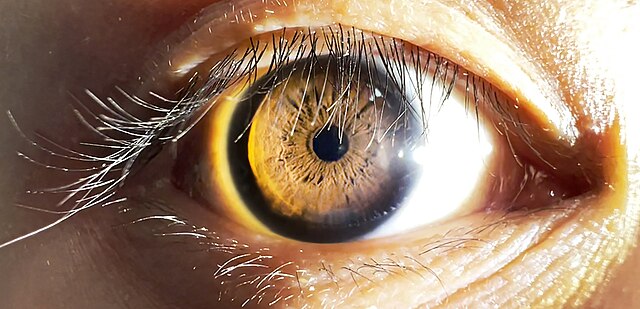The pupil is a hole located in the center of the iris of the eye that allows light to strike the retina. It appears black because light rays entering the pupil are either absorbed by the tissues inside the eye directly, or absorbed after diffuse reflections within the eye that mostly miss exiting the narrow pupil. The size of the pupil is controlled by the iris, and varies depending on many factors, the most significant being the amount of light in the environment. The term "pupil" was coined by Gerard of Cremona.
The pupil is the central opening of the iris on the inside of the eye, which normally appears black. The grey/blue or brown area surrounding the pupil is the iris. The white outer area of the eye is the sclera. The central outermost transparent colorless part of the eye (through which we can see the iris and pupil) is the cornea.
The pupil diameter can vary greatly due to various factors (primarily the pupillary light reflex), from constriction to as small as 2 mm, to dilation larger than 8 mm in some individuals, though the maximal dilation also varies substantially by individual and decreases with age
Pupil dilated naturally to 9 mm due to dim light. The subject is an extreme case, as most individuals are not able to naturally dilate their pupils to that extent
Pupil constriction can be in response to negative emotional states
An eye is a sensory organ that allows an organism to perceive visual information. It detects light and converts it into electro-chemical impulses in neurons (neurones). It is part of an organism's visual system.
Compound eye of an Antarctic krill
Eye of a European bison
Human eye, a refractive cornea type eye.
The eyes of a mantis shrimp (here Odontodactylus scyllarus) are considered the most complex in the whole animal kingdom.








